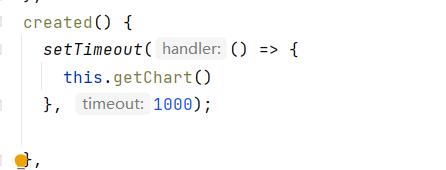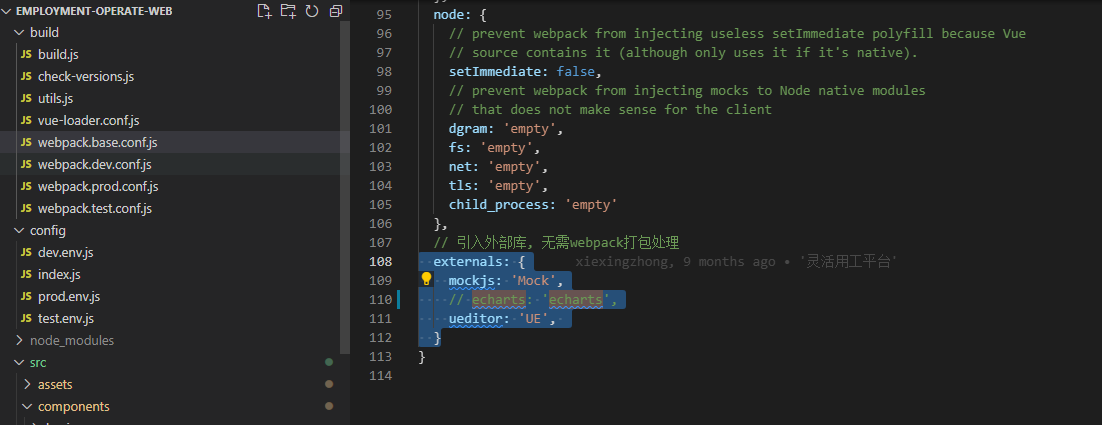When displaying the districts and counties of Taizhou, Zhejiang Province, I found an error on the page. I found that the difference in the file is that there is a “type”: “geometrycollection”
Modify node in Yuhuan JSON_Modules\charts\lib\coord\geo\parsegeojason.js code
/*
* Licensed to the Apache Software Foundation (ASF) under one
* or more contributor license agreements. See the NOTICE file
* distributed with this work for additional information
* regarding copyright ownership. The ASF licenses this file
* to you under the Apache License, Version 2.0 (the
* "License"); you may not use this file except in compliance
* with the License. You may obtain a copy of the License at
*
* http://www.apache.org/licenses/LICENSE-2.0
*
* Unless required by applicable law or agreed to in writing,
* software distributed under the License is distributed on an
* "AS IS" BASIS, WITHOUT WARRANTIES OR CONDITIONS OF ANY
* KIND, either express or implied. See the License for the
* specific language governing permissions and limitations
* under the License.
*/
/**
* AUTO-GENERATED FILE. DO NOT MODIFY.
*/
/*
* Licensed to the Apache Software Foundation (ASF) under one
* or more contributor license agreements. See the NOTICE file
* distributed with this work for additional information
* regarding copyright ownership. The ASF licenses this file
* to you under the Apache License, Version 2.0 (the
* "License"); you may not use this file except in compliance
* with the License. You may obtain a copy of the License at
*
* http://www.apache.org/licenses/LICENSE-2.0
*
* Unless required by applicable law or agreed to in writing,
* software distributed under the License is distributed on an
* "AS IS" BASIS, WITHOUT WARRANTIES OR CONDITIONS OF ANY
* KIND, either express or implied. See the License for the
* specific language governing permissions and limitations
* under the License.
*/
/**
* Parse and decode geo json
*/
import * as zrUtil from 'zrender/lib/core/util';
import Region from './Region';
function decode(json) {
if (!json.UTF8Encoding) {
return json;
}
var jsonCompressed = json;
var encodeScale = jsonCompressed.UTF8Scale;
if (encodeScale == null) {
encodeScale = 1024;
}
var features = jsonCompressed.features;
for (var f = 0; f < features.length; f++) {
var feature = features[f];
var geometry = feature.geometry;
if (geometry.type === 'Polygon') {
var coordinates = geometry.coordinates;
for (var c = 0; c < coordinates.length; c++) {
coordinates[c] = decodePolygon(coordinates[c], geometry.encodeOffsets[c], encodeScale);
}
} else if (geometry.type === 'MultiPolygon') {
var coordinates = geometry.coordinates;
for (var c = 0; c < coordinates.length; c++) {
var coordinate = coordinates[c];
for (var c2 = 0; c2 < coordinate.length; c2++) {
coordinate[c2] = decodePolygon(coordinate[c2], geometry.encodeOffsets[c][c2], encodeScale);
}
}
}
} // Has been decoded
jsonCompressed.UTF8Encoding = false;
return jsonCompressed;
}
function decodePolygon(coordinate, encodeOffsets, encodeScale) {
var result = [];
var prevX = encodeOffsets[0];
var prevY = encodeOffsets[1];
for (var i = 0; i < coordinate.length; i += 2) {
var x = coordinate.charCodeAt(i) - 64;
var y = coordinate.charCodeAt(i + 1) - 64; // ZigZag decoding
x = x >> 1 ^ -(x & 1);
y = y >> 1 ^ -(y & 1); // Delta deocding
x += prevX;
y += prevY;
prevX = x;
prevY = y; // Dequantize
result.push([x/encodeScale, y/encodeScale]);
}
return result;
}
export default function parseGeoJSON(geoJson, nameProperty) {
decode(geoJson);
return zrUtil.map(
zrUtil.filter(geoJson.features, function (featureObj) {
if (featureObj.geometry.geometries) {
let geometry = featureObj.geometry.geometries.map(i => {
return i.coordinates;
});
let { type, properties} = featureObj;
return {
type,
properties,
geometry
};
}
// Output of mapshaper may have geometry null
return (
featureObj.geometry &&
featureObj.properties &&
featureObj.geometry.coordinates &&
featureObj.geometry.coordinates.length > 0
);
}),
function (featureObj) {
var properties = featureObj.properties;
var geo = featureObj.geometry;
var coordinates = geo.coordinates;
var geometries = [];
if (geo.type === "GeometryCollection") {
let geometry = {
type: "Polygon"
};
let coordinatesArr = featureObj.geometry.geometries.map(i => {
return i.coordinates;
});
geometry.coordinates = coordinatesArr;
console.log(coordinatesArr, "coordinatesArr");
coordinatesArr.forEach(i => {
geometries.push({
type: "polygon",
// According to the GeoJSON specification.
// First must be exterior, and the rest are all interior(holes).
exterior: i[0],
interiors: i.slice(1)
});
});
}
if (geo.type === "Polygon") {
console.log("coordinatesPolygon", coordinates);
geometries.push({
type: "polygon",
// According to the GeoJSON specification.
// First must be exterior, and the rest are all interior(holes).
exterior: coordinates[0],
interiors: coordinates.slice(1)
});
}
if (geo.type === "MultiPolygon") {
zrUtil.each(coordinates, function (item) {
if (item[0]) {
geometries.push({
type: "polygon",
exterior: item[0],
interiors: item.slice(1)
});
}
});
}
console.log(
properties[nameProperty || "name"],
geometries,
properties.cp,
"asdfasdfasdf"
);
var region = new Region(
properties[nameProperty || "name"],
geometries,
properties.cp
);
region.properties = properties;
return region;
})
}







